

School Killers — The List. In the late 1990s, it seemed like an epidemic had hit American schools: Children were acquiring guns and bombs, and then going to school to kill teachers and classmates.
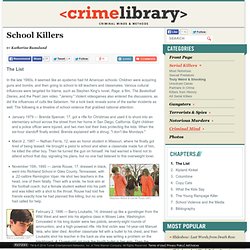
Various cultural influences were targeted for blame, such as Stephen King's novel, Rage, a film, The Basketball Diaries, and the Pearl Jam video, "Jeremy. " Violent videogames also entered the discussions, as did the influences of cults like Satanism. Yet a look back reveals some of the earlier incidents as well. The following is a timeline of school violence that grabbed national attention: January 1979 — Brenda Spencer, 17, got a rifle for Christmas and used it to shoot into an elementary school across the street from her home in San Diego, California. Stephen Abbot & Jamie Rous (AP) November 15th, 1995 — Jamie Rouse, 17, dressed in black, went into Richland School in Giles County, Tennessee, with a .22-calibre Remington Viper.
Barry Loukaitis (AP) Luke Woodham (AP) Michael Carneal (AP) April 24, 1998 — Andrew J. List of rampage killers. This is a partial list of rampage killings.
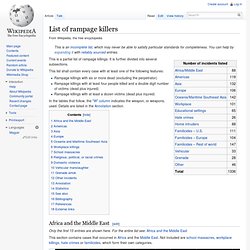
It is further divided into several subsections. This list shall contain every case with at least one of the following features: Rampage killings with six or more dead (excluding the perpetrator)Rampage killings with at least four people killed and a double digit number of victims (dead plus injured)Rampage killings with at least a dozen victims (dead plus injured) In the tables that follow, the "W" column indicates the weapon, or weapons, used. Details are listed in the Annotation section. Africa and the Middle East[edit] Only the first 15 entries are shown here. This section contains cases that occurred in Africa and the Middle East. Americas[edit] Only the first 15 entries are shown here. This section contains cases that occurred in the Americas. Not included are school massacres, workplace killings, hate crimes or familicides, which form their own categories. Asia[edit] Only the first 15 entries are shown here.
Europe[edit] Workplace killings[edit] BROWN, DEBRA DENISE #45. Hi-Fi murders. The Hi-Fi murders were the brutal killings of three people during an armed robbery at a home audio store called the Hi-Fi Shop[2] in Ogden, Utah, on April 22, 1974.
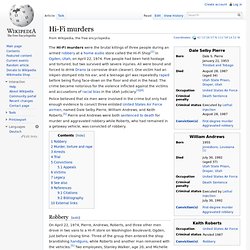
Five people had been held hostage and tortured, but two survived with severe injuries. All were bound and forced to drink Drano (a corrosive drain cleaner). One victim had an inkpen stomped into his ear, and a teenage girl was repeatedly raped before being flung face-down on the floor and shot in the head. The crime became notorious for the violence inflicted against the victims and accusations of racial bias in the Utah judiciary.[3][4] Police believed that six men were involved in the crime but only had enough evidence to convict three enlisted United States Air Force airmen, named Dale Selby Pierre, William Andrews, and Keith Roberts.[5] Pierre and Andrews were both sentenced to death for murder and aggravated robbery while Roberts, who had remained in a getaway vehicle, was convicted of robbery. Robbery[edit] Arrests[edit] Wichita Massacre. The Wichita Massacre, also known as The Wichita Horror,[1] was a murder/assault/rape/robbery spree perpetrated by brothers Reginald and Jonathan Carr against several people in the city of Wichita, Kansas in December 2000.
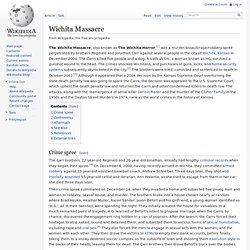
The Carrs killed five people and a dog. A sixth victim, a woman known as HG, survived a gunshot wound to the head. The crimes shocked Wichitans, and purchases of guns, locks, and home security systems subsequently skyrocketed in the city.[2] The brothers were tried, convicted and sentenced to death in October 2002.[3] Although it appeared that a 2004 decision by the Kansas Supreme Court overturning the state death penalty law was going to spare the Carrs, the decision was appealed to the U.S. Supreme Court, which upheld the death penalty law and returned the Carrs and other condemned killers to death row. Crime spree[edit] Their crime spree culminated on December 14, when they invaded a home and subjected five young men and women to robbery, sexual abuse, and murder. Eight Chicago nurses murdered, killer identified by tattoo seen by nurse who was hiding under bed. Richard Speck by David Lohr On the Sunday morning of July 14, 1966, residents on South Chicago’s East 100th Street were suddenly awakened by a woman’s screams.
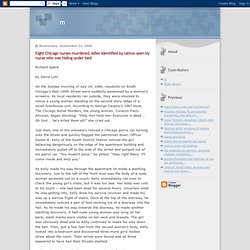
As local residents ran outside, they were shocked to notice a young woman standing on the second story ledge of a small townhouse unit.